Livestorm vs. Crowdcast: 2025 Comparison
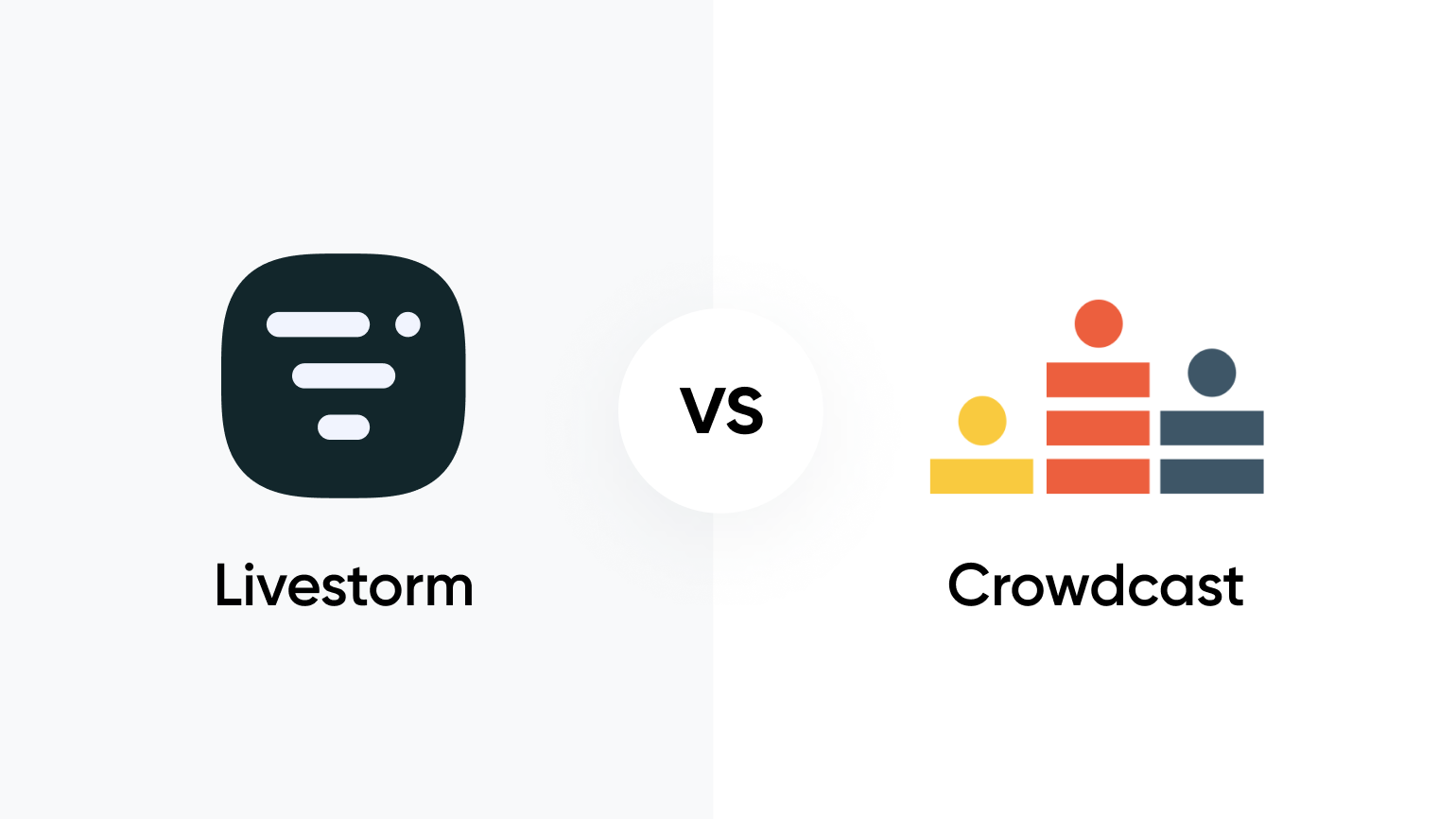
Finding the best webinar platform for your brand can be hard, especially when there are so many options to choose from.
If you’ve been looking at the different tools available to host your webinars, you’ve probably encountered tools such as Livestorm and Crowdcast.
Both platforms offer a basic coverage of the features you need to run webinars, no matter what your objective is. But how do they compare to one another in terms of offering, value, and pricing?
In this article we'll take a look at the key features and offering each platform has to offer. Let's jump right in.
How we sourced this data
To make sure we provide you with the best and most unbiased comparison possible, we look at 20+ websites.
These websites include user-review websites, specifically those specialized in SaaS, and the websites of the mentioned tools of course.
Information from these different sources were prioritized in the following order:
- Third party websites (no sponsored posts/content)
- User reviews (G2, Gartner, marketplaces)
- Websites of the tools themselves
Some examples of those relevant sources:
- Livestorm reviews on G2
- Livestorm reviews on Capterra
- Crowdcast review on G2
- Crowdcast reviews on Capterra
- Livestorm reviews on HubSpot marketplace
Pricing, viewer limits, feature list, and customer support options are sourced directly on the website of the tools themselves.
We will try to provide the most unbiased review possible. However, the quality of the viewer experience for each tool is subjective. We will be judging it on the modernity and interactivity of the experience.
Before we get into the key features, here’s a brief overview of the two products, including Livestorm vs Crowdcast pricing and online review ratings.
Livestorm overview
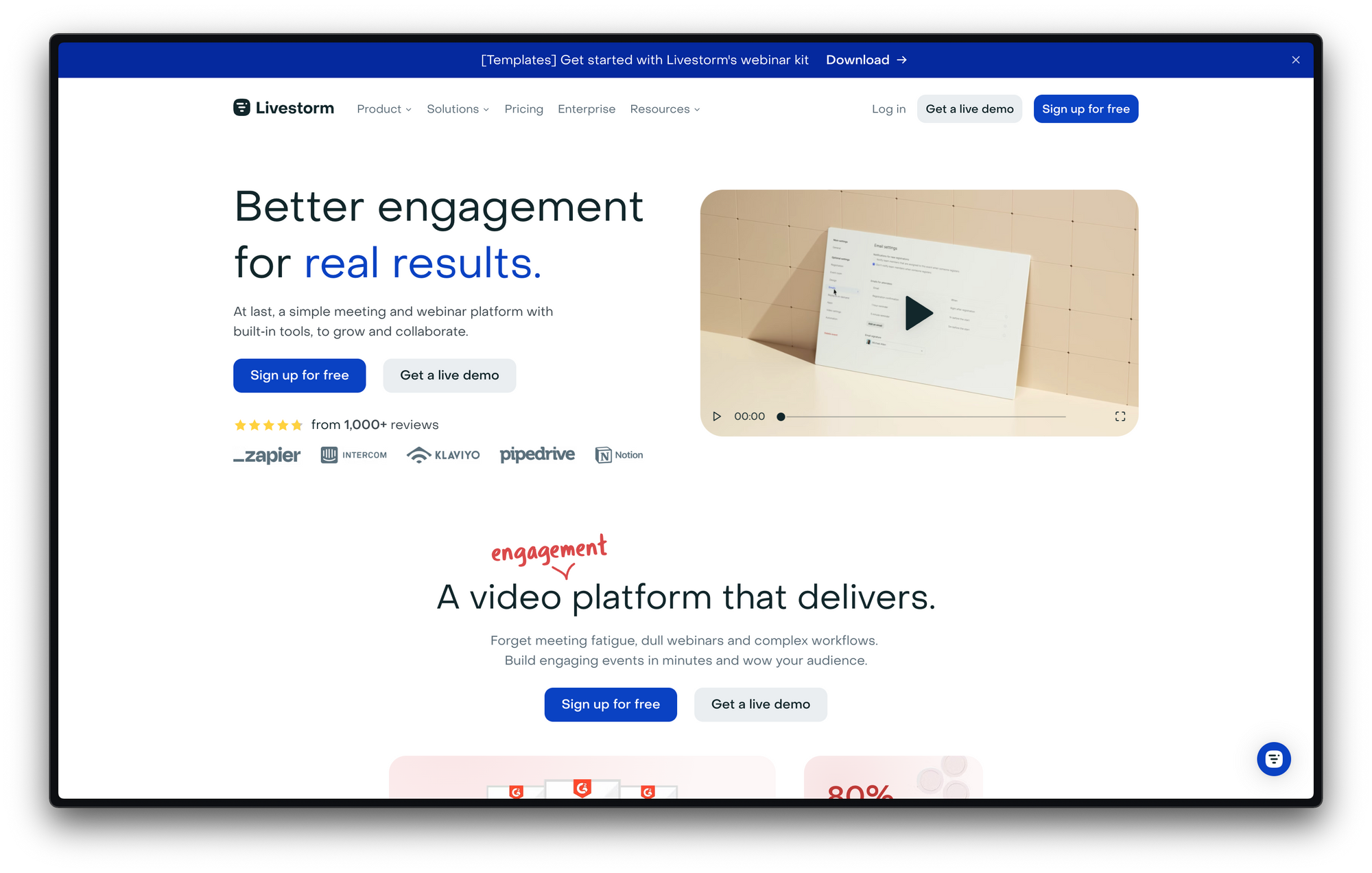
Cost
Livestorm offers monthly and yearly (20% off) pricing plans. They are centered around active contacts: unique people who register or join (one or several) Livestorm events.
- <100 active contacts: $99/month
- <200 active contacts: $198/month
- <500 active contacts: $495/month
- Pricing plans for 500+ active contacts are unavailable
Team members are unlimited on all pricing plans, but some key features only unlock after certain pricing tiers:
- HubSpot integration: Pro plan
- Salesforce integration: Enterprise plan
- PowerPoint embed: Enterprise plan
Free plan: Livestorm has a free plan that's good for testing out the platform internally, but won't be enough for most companies to run a "real" webinar. The plan includes:
- 30 active contacts/month
- 20 minutes/session
- Base integrations + features
- Email support only
Free trial: No. But freemium plan available.
Reviews
Gartner reviews: 4.4/5
Ease of use: 9.1/10
Support: 8.8/10
Support options: Email and live chat (depending on plan).
Platform availability: Online, no download, all devices (mobile and desktop).
Livestorm is one of the newer webinar platforms on the market, and at first glance, it looks like they cover pretty much everything you need to run webinars.
Users report it's relatively easy to use, and having an unlimited team member policy makes it easy to scale webinar efforts as you onboard new people. The price of Livestorm will only increase if you are getting more leads.
However, some features being gated to higher pricing plans can make it very expensive for smaller teams wanting to integrate webinar data into their CRM.
They also offer SSO, quarterly business reviews and technical support consulting for enterprise plans.
Looking for an alternative? Check out our top 10 Livestorm alternatives.
Crowdcast overview
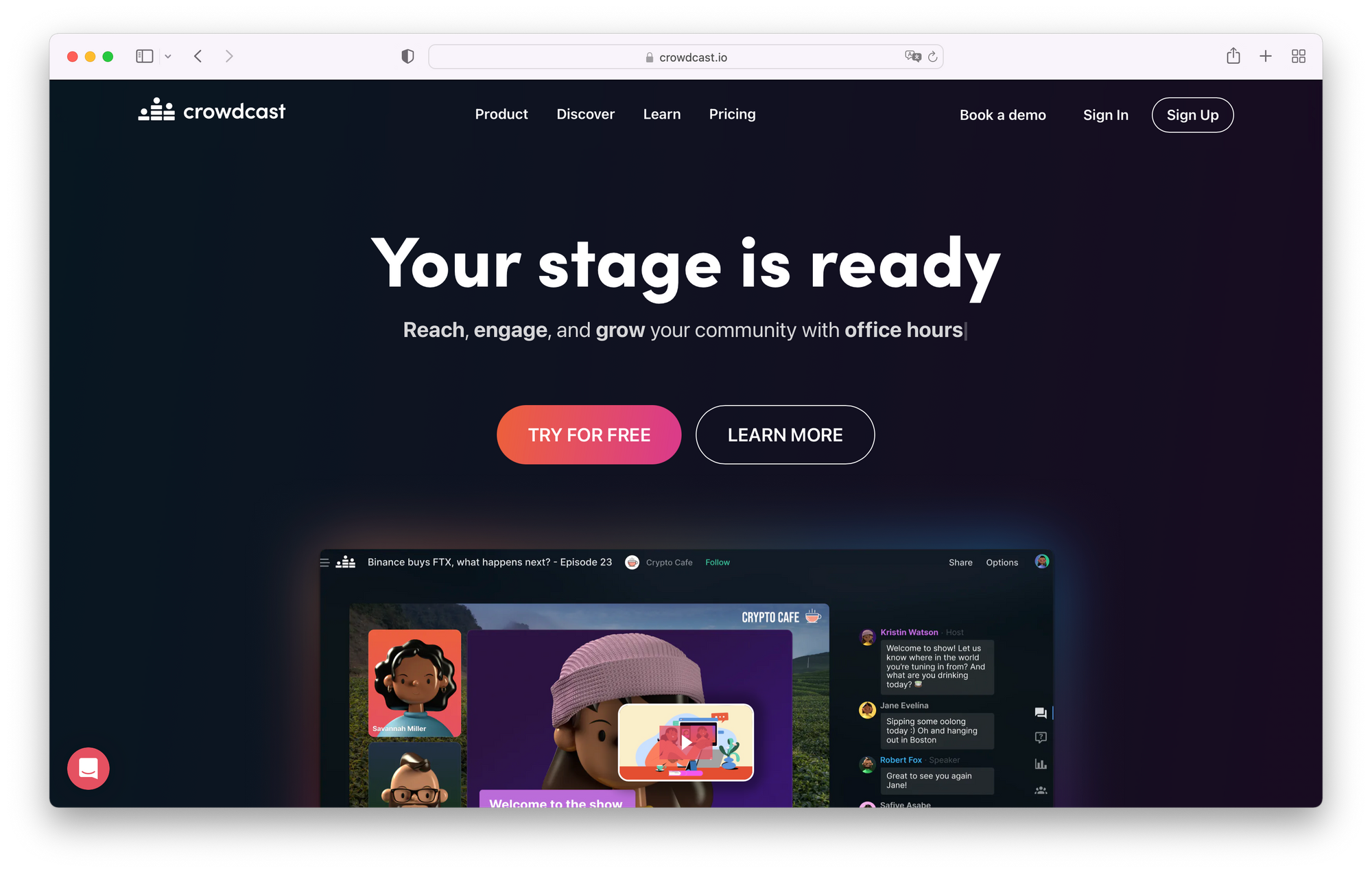
Cost
Crowdcast offers a very transparent and cheap pricing model based on the number of live attendees to your events.
These start at:
- $49 /month for <100 live attendees (with 1 host seat)
- $89 /month for <250 live attendees (with 2 host seats)
- $195 /month for <1000 live attendees (with 5 host seats)
If you go over these limits you will be charged 15 cents per additional contact, which can quickly rack up your bill at the end of the month.
Note that host seats are limited, which can be a problem if you have a large team running webinars on Crowdcast. You can add more for $29 /seat/month.
However, some key features only unlock on some of the more expensive Pro plans:
- Multicasting (LinkedIn, YouTube, Twitch, etc.)
- Custom registration fields
- 4-hour max session length
Free plan: Crowdcast does not offer a free plan.
Free trial: Crowdcast offers a 2-week limited free trial with 10 live attendees & 60 minute sessions with all business features included. This is good to test the platform but most likely won't be enough to run a real webinar.
Reviews
Capterra reviews: 4.6/5 (96 ratings)
Ease of use: 9.4/10
Support: 9.3/10
Support options: Email or live chat.
Platform availability: Online, no download, all devices (mobile and desktop).
Crowdcast is a relatively cheap webinar platform compared to other options on the market, and they offer all the main features you need to run webinars.
They focus primarily on the community-building webinars use case, instead of the typical lead generation one. This is made obvious by their lack of CRM integrations (HubSpot, Salesforce, etc.).
Their interface is relatively user-friendly (and beginner-friendly) making it a good choice for companies that are just getting started with webinars, or who can't invest a lot of resources into the channel.
Crowdcast allows mature content on their platform which means they can be flagged by some firewalls, preventing viewers from accessing the content. This is especially the case for employees of enterprise companies that have tighter restrictions. Many Crowdcast users have experience reliability issues and have started to move away from the platform.
They also do not currently offer HubSpot or Salesforce integrations, meaning you have to use Zapier to send registrant data to and from your CRM. This requires extra work to set up and maintain from your team, and often won't cover all the same functionalities of a native integration.
Their per-organizer pricing model also means that it can be complex to enable other teams than the core webinar team to run their own sessions.
Looking for an alternative? Check out our top 10 Crowdcast alternatives.
Livestorm vs. Crowdcast Comparison
As you can see from the overview of Livestorm and Crowdcast, they offer very similar products. This makes it difficult for users that are trying to figure out which solution best fits their needs.
Let's compare these two tools across 5 main topics:
- Live experience (host and speaker)
- Pre- and post-webinar experience
- Viewer experience
- Integrations
- Support
1. Live experience
As a host, the tool you choose is going to have a big impact on your capacity to put on a good show for your audience.
Most webinar tools offer a webinar studio to help you run more interactive webinars. Livestorm has just that: an admin interface where you can create, edit, start polls, manage microphone and camera access, share screen, see live attendees and more.
Livestorm's admin interface is user-friendly even though it offers quite a few features to choose from. It can be easy to get lost between the viewer list, questions, polls, chat, and all the other options. But it gets the job done.
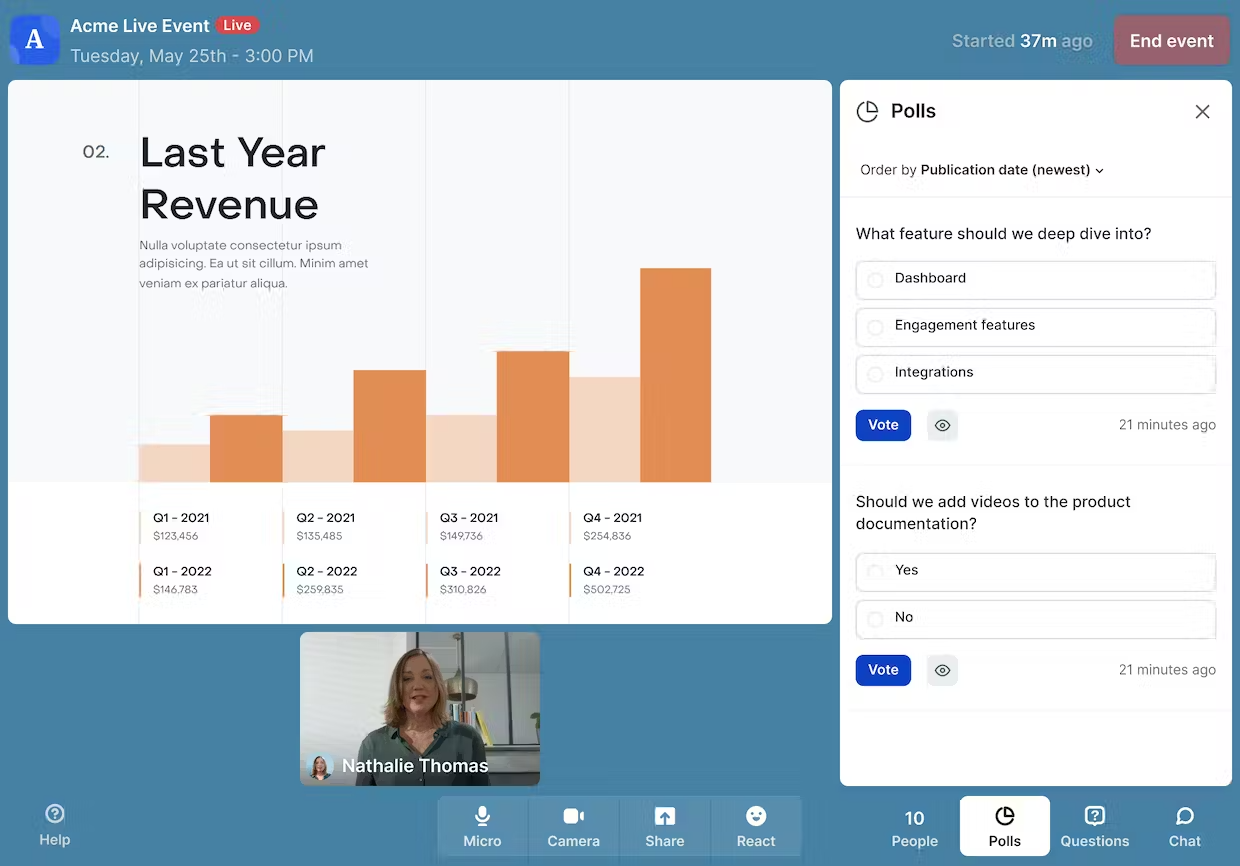
Crowdcast has a "webinar studio" too, with the addition of a Greenroom where you can practice your webinar before going live, and tee up speakers before launching your event. They also have the "Wing" where guests and speakers can sit before being invited to join the stage. This gives you a lot more control over what your audience sees.

The branding features are much better with Crowdcast (see screenshot) while having the same coverage of engagement features. Providing a coherent brand experience for your viewers will positively impact engagement and at the end of the day will help driving more revenue.
Both tools offer similar speaker and moderator options to run your webinar, but Crowdcast has a few more useful features (especially when it comes to branding).
Winner: Crowdcast
2. Pre- and post-webinar experience
When it comes to your viewers' experience, Livestorm and Crowdcast are pretty evenly matched when it comes to the pre-and post-webinar experience, and both cover the basic features.
They both offer customizable and branded registration pages, automated reminder and follow-up emails, and replays (Crowdcast and Livestorm do not record all webinars by default, so be careful if you go with them to run your events).
Livestorm has features for recurring events and simulive sessions (providing a live experience to the viewer with nobody managing the event), that Crowdcast doesn't offer. They also provide more detailed viewer data.
Crowdcast has a channel that gives an overview of all upcoming and replay events that users can follow to be notified about your upcoming events. Livestorm has a similar version but more simplistic.
But both tools allow you to build your own landing pages with 3rd party tools and send registrants to your webinars via automation tools.
Because of the additional features and similar ease-of-use, Livestorm takes the win in this category.
Winner: Livestorm
3. Viewer experience
Livestorm offers a relatively modern viewer experience and lets you brand your webinar with profile pictures, background images, logos, social links, and more.
Polls, questions, and chat all have their own separate panels - forcing users to navigate back and forth to cover everything that's going on. This distracts users from your content, and reduces engagement on polls (because users might miss them).
Advanced users can also use the Livestorm SDK to personalize the experience even further, but this requires technical knowledge most webinar teams don't have access to.
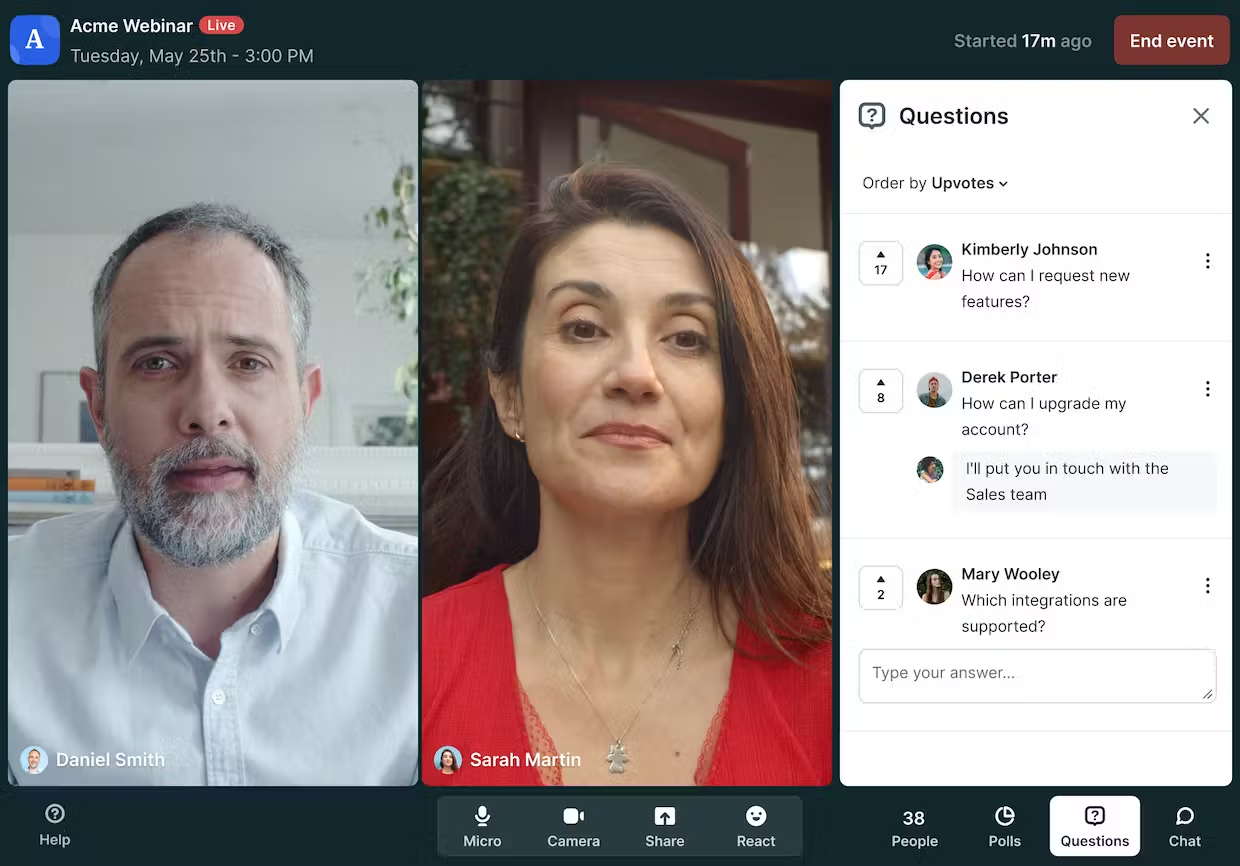
Crowdcast also has similar features to brand your webinar as mentioned previously, so the viewer experience is a lot closer to your brand.
Their interface also has a lot of tabs that can confuse users and have them spending more of their energy clicking around than actually focusing on your content. They have a modern chat experience which drives more interaction with the audience (but also between audience members themselves).
Crowdcast is clearly built for community-building in mind.

Both platforms let you stream in 720p, but Livestorm has a more professional feel to it than Crowdcast. This makes it, on average, a better choice for businesses.
Winner: Livestorm
4. Integrations
Livestorm integrates with Google Analytics, Intercom, HubSpot, Salesforce, and many other tools of the modern marketing stack. However, some of these integrations are only available on their more expensive plans. Some users have reported that these native CRM integrations are "good enough to get the job done" but far from what they were expecting in terms of quality. Livestorm also offers an API giving tech-enabled webinar teams more flexibility when it comes to running and automating they webinar strategy.
Looking for the webinar tool with the best HubSpot integration?
Check out Contrast for free (4.9* on the HubSpot Marketplace).
Crowdcast does not offer any native CRM integrations, but does have an intergration with Stripe if you want to run paid webinars. They also have integrations with ConvertKit, Drip, and Patreon.
Both Crowdcast and Livestorm have Zapier integrations, allowing you to connect them to 3000+ tools. They both offer actions around the participant registering, attending a live and to register people to webinars. However, Livestorm offers both triggers and actions around organizing webinars: create event, create session, trigger when webinar is published. This makes it easier to automate the operations surrounding webinars.

Winner: Livestorm
5. Support
Both tools offer very similar support options: email and live chat.
Livestorm has a better help center than Crowdcast, making self-onboarding onto the tool easier and solving recurring problems or questions you might run into. They also offer additional support and "Livestorm Learning" on their Business and Enterprise plans, and shadowing by an expert for clients on their Enterprise plans (usually +$10k/year).
Crowdcast also provides support documentation in the form of a help center where they answer basic questions you might have but it's more limited when it comes to complex topics.
Users rate the quality of Crowdcast's support higher (9.3/10) than Livestorm's — even if the options are limited.
None of the two platforms is a clear winner on average across all plans, but the numbers have spoken (and we listen).
Winner: Crowdcast
Which is better — Livestorm or Crowdcast?
So we just took a look at each of these platforms, but which one is going to take first place?
If your only goal is to run webinars while investing the least amount of resources possible, Crowdcast is going to be the best choice for you. However, it won't be the best choice for your audience and will require extra work to integrate with your CRM or other tools of your marketing stack.
If you're looking to put on a more modern and professional webinar experience, Livestorm is the best option even if it will be a bit more costly. The unlimited team member policy will allow you to scale webinar efforts into other teams more easily, and the integrations to other tools will allow you to leverage webinar data to close more deals and improve your strategy.
Go beyond webinars
Both Livestorm and Crowdcast are great tools for running your webinars.
However, there are many other alternatives to these two webinar tools offering a wide variety of features and pricing plans — and of course don't forget to take a look at Contrast.
Contrast is the most modern webinar tool on the market, covering all the basic features you're looking for in a tool while providing a fun, authentic and engaging experience to your audience.
We also offer tools to help you repurpose your webinar, a Netflix-like branded Channel to host all of your replays and upcoming events, all while providing the highest quality branded video experience on the market and stellar CRM integrations.

